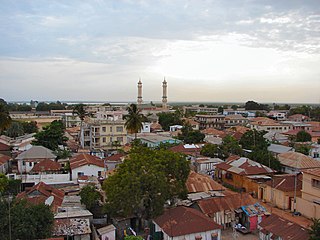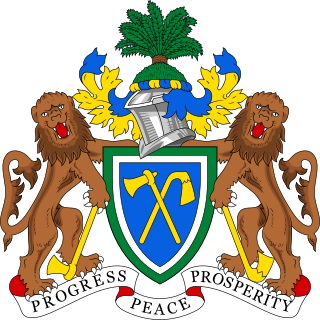
Banjul, officially the City of Banjul, is the capital and fourth largest city of The Gambia. It is the centre of the eponymous administrative division which is home to an estimated 400,000 residents, making it The Gambia's largest and most densely populated metropolitan area. Banjul is on St Mary's Island, where the Gambia River enters the Atlantic Ocean. The population of the city proper is 31,301, with the Greater Banjul Area, which includes the City of Banjul and the Kanifing Municipal Council, at a population of 413,397. The island is connected to the mainland to the west and the rest of Greater Banjul Area via bridges. There are also ferries linking Banjul to the mainland at the other side of the river.

The Gambia River is a major river in West Africa, running 1,120 kilometres (700 mi) from the Fouta Djallon plateau in north Guinea westward through Senegal and The Gambia to the Atlantic Ocean at the city of Banjul. It is navigable for about half that length.

Kunta Kinteh Island, formerly called James Island and St Andrew's Island, is an island in the Gambia River, 30 km (19 mi) from the river mouth and near Juffureh in the Republic of the Gambia. Fort James is located on the island. It is less than 3.2 km from Albreda on the river's northern bank. As an important historical site in the West African slave trade, it is listed as a UNESCO World Heritage Site, together with related sites including a ruined Portuguese chapel and a colonial warehouse in Albreda, the Maurel Frères Building in Juffureh, and Fort Bullen and Six-Gun Battery, which are located at the mouth of the Gambia River.

Kunta Kinte is a character in the 1976 novel Roots: The Saga of an American Family by American author Alex Haley. Kunta Kinte was based on one of Haley's ancestors, a Gambian man who was born around 1750, enslaved, and taken to America where he died around 1822. Haley said that his account of Kunta's life in Roots is a mixture of fact and fiction.
St. Andrews Island may refer to:

Janjanbureh or Jangjangbureh is a town, founded in 1832, on Janjanbureh Island, also known as MacCarthy Island, in the Gambia River in eastern Gambia. Until 1995, it was known as Georgetown and was the second largest town in the country. It is the capital of Janjanbureh Local Government Area, and the Janjanbureh district. The population of the Janjanbureh LGA was 127,333 at the 2013 population census.

Central River is the largest of the five administrative divisions of the Gambia. Its capital is Janjanbureh, on MacCarthy Island. The largest settlement is Bansang, with an estimated population in 2008 of 8,381.
The Gambia is divided into eight local government areas. They are:
- Banjul
- Basse
- Brikama
- Janjanbureh
- Kanifing
- Kerewan
- Kuntaur
- Mansakonko
Kuntaur is a town located in central part of the Gambia.

The Trans-Gambia Highway is a major highway in The Gambia, running across the centre of the nation in a north–south direction.

The Gambia is subdivided into 43 districts. They are listed below by Local Government Area, each with its population at the 15 April 2013 census.

The Gambia is divided into five administrative Regions and one City. The divisions of the Gambia are created by the Independent Electoral Commission in accordance to Article 192 of the National Constitution.
The tourism industry today in the Gambia started when a party of 300 Swedish tourists arrived in 1965. That pioneering trip was organised by a Swede named Bertil Harding together with the tour operators Vingresor. It was seen as an ideal place to escape the harsh winter months of Scandinavia where Europeans would enjoy not only sun, sand and beaches but also experience the excitement of a real African holiday. It also offered a new opening for an affordable holiday to increasing numbers of traveling Europeans.

Dog Island is a small island, situated on the Gambia River in the Republic of the Gambia about 13 kilometres from the mouth of the river to the Atlantic Ocean. The area of the island is less than 3.5 hectares. During low tide the island is connected to the mainland, but during high tide it is separated by about 150 metres from the headland of Dog Island Point on the north bank of the river. The island is named after the sound made by the resident baboons, which from a distance sounds like dogs barking.
The Portuguese Chapel of Albreda or just Albreda Chapel, also Portuguese Chapel of San Domingo, is the name given to a Catholic chapel built by Portuguese explorers in the fifteenth century in the area of Albreda which is now a part of the African country of Gambia. It is currently in ruins and was stabilized for protection in 2000.
Sir Alexander Grant was a British Army officer who served as the first Commandant of St Mary's Island from 1816 to 1826.
Fatou Sanyang Kinteh also known as Fatou Kinteh is a Gambian politician and women's rights activist. She currently serves as the Gambian minister for women's affairs, children, and social welfare. She also serves as the national coordinator of The Gambia for Gender-Based Violence and Female Genital Mutilation.









